GIGABYTE F2A88X-UP4 Review
by Ian Cutress on March 24, 2014 11:59 AM EST- Posted in
- Motherboards
- AMD
- Gigabyte
- FM2
Scientific and Synthetic Benchmarks
2D to 3D Rendering –Agisoft PhotoScan v1.0: link
Agisoft Photoscan creates 3D models from 2D images, a process which is very computationally expensive. The algorithm is split into four distinct phases, and different phases of the model reconstruction require either fast memory, fast IPC, more cores, or even OpenCL compute devices to hand. Agisoft supplied us with a special version of the software to script the process, where we take 50 images of a stately home and convert it into a medium quality model. This benchmark typically takes around 15-20 minutes on a high end PC on the CPU alone, with GPUs reducing the time.
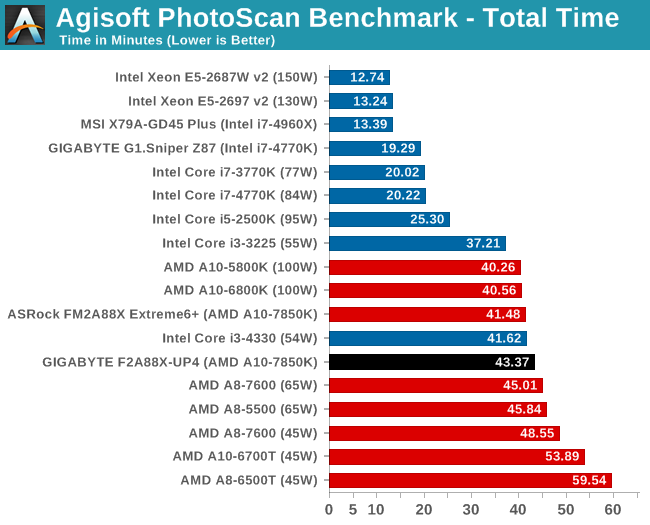
Console Emulation –Dolphin Benchmark: link
At the start of 2014 I was emailed with a link to a new emulation benchmark based on the Dolphin Emulator. The issue with emulators tends to be two-fold: game licensing and raw CPU power required for the emulation. As a result, many emulators are often bound by single thread CPU performance, and general reports tended to suggest that Haswell provided a significant boost to emulator performance. This benchmark runs a Wii program that raytraces a complex 3D scene inside the Dolphin Wii emulator. Performance on this benchmark is a good proxy of the speed of Dolphin CPU emulation, which is an intensive single core task using most aspects of a CPU. Results are given in minutes, where the Wii itself scores 17.53; meaning that anything above this is faster than an actual Wii for processing Wii code, albeit emulated.
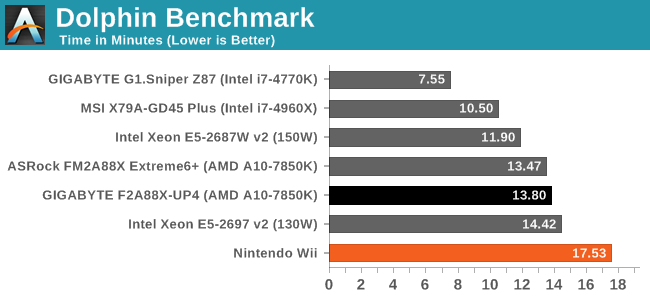
Point Calculations – 3D Movement Algorithm Test: link
3DPM is a self-penned benchmark, taking basic 3D movement algorithms used in Brownian Motion simulations and testing them for speed. High floating point performance, MHz and IPC wins in the single thread version, whereas the multithread version has to handle the threads and loves more cores.
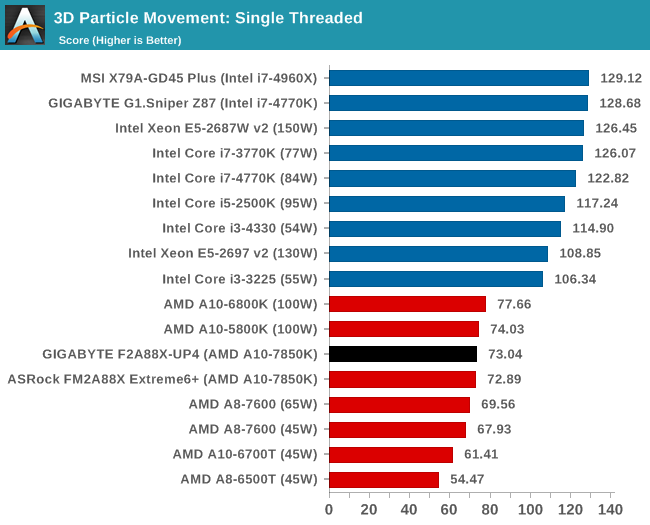
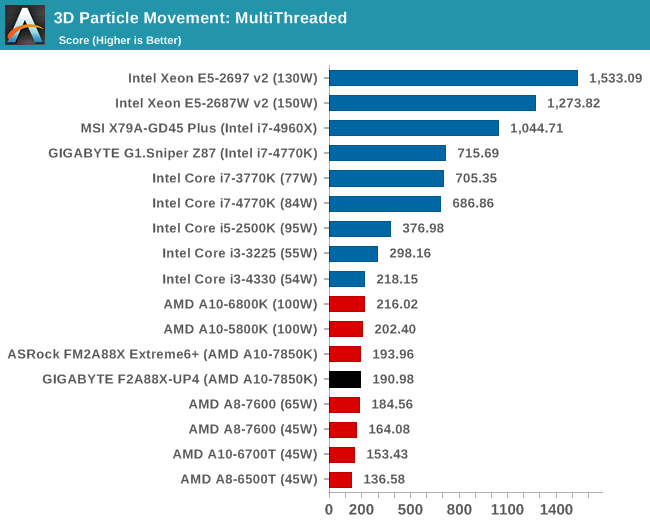
Encryption –TrueCrypt v0.7.1a: link
TrueCrypt is an off the shelf open source encryption tool for files and folders. For our test we run the benchmark mode using a 1GB buffer and take the mean result from AES encryption.

TrueCrypt had a significant defecit to the Extreme6+, suggesting that the Turbo mode on the UP4 during this benchmark was not engaging properly.
Synthetic – 7-Zip 9.2: link
As an open source compression tool, 7-Zip is a popular tool for making sets of files easier to handle and transfer. The software offers up its own benchmark, to which we report the result.
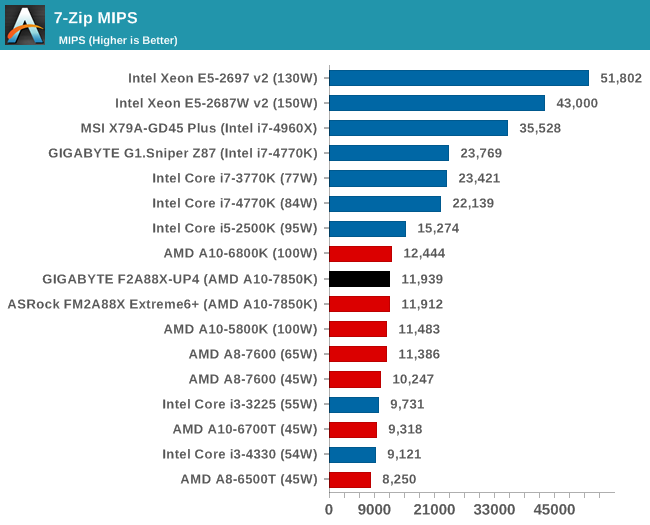










18 Comments
View All Comments
apertotes - Monday, March 24, 2014 - link
The old EasyTune software may end up being a blessing in disguise. The newer Intel software has a nasty issue with global hotkeys and some non-English keyboard layouts. Those hotkeys can not be disabled or remapped and take control of some very usual key combinations like @,# or €.DukeN - Monday, March 24, 2014 - link
Good mining board - inexpensive combined with a cheap AMD proc, even has onboard power button wired in.popej - Monday, March 24, 2014 - link
Again dynamic range "From Graph"? Can't you believe, that numeric value and provided graph are only different presentation of the same result?Noise level drawn on the graph directly depends on FFT size, make FFT calculation with twice the size of data and it will drop by 3dB. RMAA probably draws graph normalized to 1Hz FFT bins, but it is only a convention, nothing there can suggest 102dB DNR.
StevoLincolnite - Monday, March 24, 2014 - link
I'm really not all that interested in ATX sized FM2+ boards.However, where I think there is a gap that needs to be filled is actually in the AM3+ sector.
SERIOUSLY Where are the ITX based AM3+ boards!?
I have a Phenom 2 x6 and an FX 8120 laying around that would love to find their homes in a Mini-ITX system.
meacupla - Tuesday, March 25, 2014 - link
I think it's just not possible to load up an ITX board with that many voltage regulators.Asrock's first FM2 ITX board went up in flames, and an A10 is lower power than Phenom or FX.
bdub951 - Monday, March 24, 2014 - link
ITX is where FM2+ shines. We really need a look at the various FM2+ ITX offerings. I've dealt with the GA-F2A88XN-WIFI and while the board itself is very nice, the BIOS and software really needs some work. Overclocking is a mixed bag on FM2+ due to the CPU throttling to 3Ghz under iGPU load. iGPU overclocking is the most important distinguishing factor between boards and the GA-F2A88XN-WIFI (possibly the rest from Gigabyte too) doesn't appear to allow the iGPU to clock beyond 960Mhz even though you can set it higher in BIOS.DrMrLordX - Monday, March 24, 2014 - link
The 3 ghz P5 state throttling under iGPU load can be defeated:http://www.overclock.net/t/1459225/i-have-custom-l...
. . . but it isn't an elegant solution. I think the UP4 has been reported to restrict iGPU overclocking to 960 mhz by some folks at overclock.net, but my memory is fuzzy on that point.
bdub951 - Tuesday, March 25, 2014 - link
I'm a little disappointed that Anandtech isn't able to look into issues like this. I think it's pretty important to know these things when determining what CPU and MB to go with. Why even bother with determining what CPU OC a board will support when the use of your iGPU just causes it to throttle to P5 making the OC useless. Given this appears to be a TDP limitation that is designed into Kaveri, wouldn't it make more sense to determine the iGPU OC??Now whether this TDP limitation affects the iGPU also remains to be seen but there are reports that the iGPU throttles to 450Mhz randomly causing stuttering when it's OC'd. I believe MSI afterburner shows this.
Regardless, I think it's time for a little more disclosure from AMD as to whats happening. This is supposed to be an unlocked processor but it's clearly locked. Whether you lock via clocks, multiplier, or TDP is irrelevant, it's still locked.
DrMrLordX - Tuesday, March 25, 2014 - link
Allegedly, MSI Afterburner can be used to defeat iGPU throttling, though at least one person I've talked to has voiced the opinion that the throttling behavior may be due to excessive polling by software such as . . . MSI Afterburner (and the person I am citing may step forward to elaborate, if he wishes).As far as the p5 state throttling, some boards are supposedly able to defeat that behavior by toggling a setting such as advanced power management (APM), but it is not 100% clear whether or not that is effective. Some boards do not offer this option in their UEFI.
I agree that more disclosure and coverage of throttling issues on Kaveri would be nice. Published benchmarks are all potentially tainted by throttling behavior. I don't fault the reviewers really, Kaveri is just an odd chip. Power delivery seems to be a major concern on the FM2+ platform when hosting a Kaveri CPU.
rozquilla - Monday, March 24, 2014 - link
The link to the AMD A10-7850K (ES) processor actually links to the Intel Core i7-4960X.